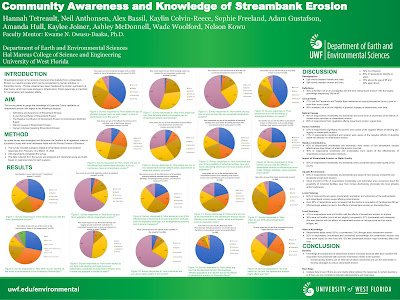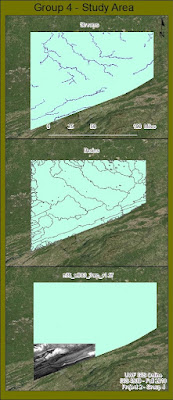The map I created for this week was accomplished by combining multiple landsat images into a single file and classifying all Mountaintop Removal Sites within group 4's study area using the unsupervised classification tool and editing attribute data, using Erdas. Then importing into arcMap to use the reclassify tool to reclassify all MTR data and remove all NON MTR data. Attached is my deliverable for project 2 MTR: analyze.
Friday, September 28, 2018
GIS 4930 - Project 2 - Mountaintop Removal: Analyze
The map I created for this week was accomplished by combining multiple landsat images into a single file and classifying all Mountaintop Removal Sites within group 4's study area using the unsupervised classification tool and editing attribute data, using Erdas. Then importing into arcMap to use the reclassify tool to reclassify all MTR data and remove all NON MTR data. Attached is my deliverable for project 2 MTR: analyze.
Tuesday, September 25, 2018
GIS 4035 - Module 4 - Ground Truthing
This assessment builds off of last weeks LU/LC module 2. 30 assessment points were chosen using a random selection method taking care to evenly distribute the points throughout the classification area. Out of the 30 points selected 6 were categorized as error (n) and 24 were categorized as correct (y).
This assessment resulted in an accuracy calculation of 80%.
Friday, September 21, 2018
GIS 4930 - Project 2 - Mountaintop Removal: Prepare
UPDATE: After importing my map files into arcMap and rerunning all tools required to recreate the hydro data files I was successfully able to create the required deliverable for project 2, A single map showing both streams data frame and basins data frame. I've also included a data frame that shows my quadrant (n36_w083_3arc_v1.tif) of group 4's study area for the mountain top removal project.
Wednesday, September 19, 2018
GIS 4048 - Module 1 Project 1
For module 1 project 1 we were tasked with creating a route map in response to an overturned tractor trailer accident. This proposed incident response message was created in order to distribute to motorists in the area in response to the accident:
"Attention all motorists. An incident involving an
overturned tractor trailer has rendered the intersection of Interstates 95 and
945, in Springfield, Virginia, untraversable. As such the following detours
have been issued: North to South 3.5 miles, South to East 3.8 miles, South to
West 9.8 miles. Please allow for at least a 10 minute delay in your travels
today. Thank you."
This map shows detour routes around the incident, proposes routes to designated shelters, informs motorists the extent of the accident, highlights locations of nearby fire stations and all major roadways, shows nearest shelter in color code.
This map was uploaded to arcgisonline.com -
https://arcg.is/0Kviu9
Tuesday, September 18, 2018
GIS 4035 - Module 3 - LULC classification
12 - Commercial and Services - areas that contained larger than home sized buildings and large parking lots
14 - Transportation - main highway
43 - Mixed forest land - all woodland area was categorized under this classification of mixed
51 - Streams and Canals - smaller streams leading from the bay were categorized as this
53 - Reservoirs - a few small retention ponds in the residential area
54 - Bays and Estuaries - the bay
62 - non-forested wetland - wetland area surrounding the bay that had no trees
GIS 4035 - Module 2 - Visual Interpretation
For the first .tif aerial image file we were tasked with interpreting tone, by classifying 5 polygon feature class files from very light to very dark, and texture, by classifying 5 polygon feature class files from very fine to very coarse.
The following map deliverable was created.
For the final .tif aerial image file we were tasked with interpreting color features when compared to a false color IR image of the same study area. The following differences were noted:
Feature
|
True Color
|
False Color
|
Stream
|
White
|
Blue
|
Forest
|
Green
|
Red
|
River
|
Green-blue
|
Blue
|
Building
|
Light-grey
|
White
|
Lot
|
Dark-grey
|
Blue
|
Friday, September 14, 2018
GIS 4930 - Project 1 Network Analyst
Alot has happened during the first couple weeks during my start into this GIS 4930 Special Topics GIS course. Me and my wife welcomed our new born son into the world, and as such I was given a week extension for the first deliverables of project 1. Since I have completed week 1 and week 2 deliverables during week 2 I am posting the entirety of project 1 in this blog post.
Project 1 Network Analyst had tasked us with creating 6 maps that involved routing, network analysis, and a multitude of refresher lessons from previous GIS courses.
For week 1, I created a Hurricane Get Ready Guide to serve as a general map highlighting all evacuation and supply routes in the Tampa Bay, Fl area in the event of a natural disaster or state of emergency. The data-set also highlights the location of all police departments, fire departments, shelters, hospitals, roads, and waterways within the study area.
For week 2, I created routes for hospital evacuation, from Tampa Bay General Hospital to two nearby hospitals in the Tampa Bay, Fl area,
Memorial Hospital, and St. Josephs Hospital, and routes for emergency personnel to transport supplies from the National Guard Armory to three nearby designated shelters, Middleton High School, Tampa Bay Blvd.
Elementary School, and Oak Park Elementary School.
All information was presented accurately and legibly in order to present an easy to follow guide that anyone could pick up and follow during times of distress in the Tampa Bay, Fl area.
Spring 2023 semester wrap up
The spring 2023 semester at UWF has been an eventful one in which I finalized the requirements for my bachelors of science in natural scien...

-
Mastering multiple platforms will result in a more precise outcome. In this weeks lab we were tasked with creating a top10 list of our cho...
-
For this weeks Module 7 we were tasked with creating a choropleth map for wine consumption in Europe. A choropleth map is a themetic map in ...
-
For this weeks Module 6, we were tasked with displaying data for Dade County, Florida in four different classification methods for symbology...















